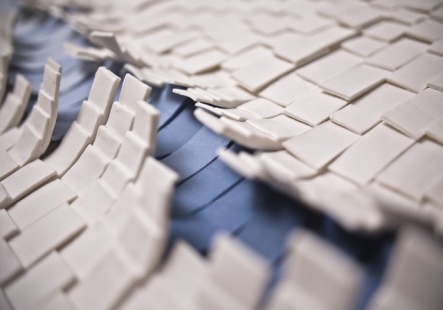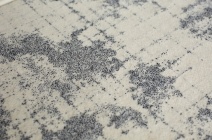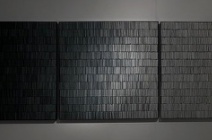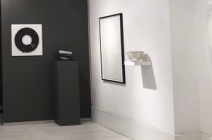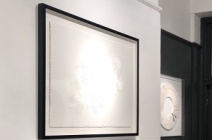The Uppermost Layer
The Uppermost Layer
An alluring collection intimating some of the many possible variations of surface and texture.
Lis Costa - Lucas Ferreira - Alison Gautrey - Richard McVetis
Lis Costa's sculpted paper works explore both organic and abstract shapes, playing with lights and shades with paper cuts to achieve a delicate result.
Using thick Fabriano paper, Lis sculpts and shapes, carving extremely thin layers to create forms. In spite of an absence of colour, richness and depth is given by the subte layering of sculpted shavings, that are accumulated and staggered, creating protruding waves and rhythms. Sometimes the paper is not cut but only slightly pushed from the back, offering contrast and inviting the eye to circulate in these three dimensional landscapes. Repetition, sequence and layering of simple carved shapes create movement and flow with an elegant simplicity.
Lucas Ferreira ‘s works are made from small hand crafted fragments of ceramic. Small flat rectangles are joined together to forming different compositions. Each fragment, the same size and shape, one next to the other, almost sewn together, accumulated to form sequences, rhythms, which are then altered by the inclusion of pieces in a different colour. White, black, blues or different shades of grey woven together to become a sumptuous fabric.
Repetition, sequence, order and interruption convey the method by which the fragments are meticulously arranged creating geometric and abstract shapes. Some of the works appear at the same time in a series, where the alteration of the black pieces marks different spaces and rhythm in the compositions. The work is subtle, intriguing. Only a closer look will offer the viewer a rendition of what it is about. “My work is inspired by geological formations. I enjoy crafting minimalist textured studies inspired by how rocky surfaces are reshaped over time.”
Almost paper-like, Alison Gautrey’s spun porcelain vessels in a monochrome palette are luminously translucent. These weightless pieces capture the feeling of movement within the simplicity of form. In these sculptural works, Alison successfully combines certain randomness in the process with an intuitive vision given by her design background, paired with her knowledge of material.
There is a distinct contrast between the exterior and interior surfaces where technique and tonal variation create unique patterns. The interior is blended and chaotic whilst the exterior remains calm with controlled bands of defined pigment.
Repetition of the same simple form allows Alison to present a range of differences and contrasts, masterly combining randomness, chance and control with the use of pigment in a delicate surface.
Richard McVetis’ subtle pieces intrigue and invite the viewer to a closer examination. With almost imperceptible hand embroidery on a soft, rich light surface his works convey aerial maps or abstract landscapes. The stitch gives life to a topography of sorts, marking time and displaying experienced craftsmanship.
McVetis' practice centres on the use of hand embroidery and reflects a preoccupation with the repetitive nature of process, exploring the subtle differences that emerge through ritualistic and habitual making. In addition, the mapping of space and marking time and form are central themes. McVetis explores the way time and place are felt, experienced and constructed. Ideas are often developed in response to, or created specifically to a moment, visualising and making this a tactile and tangible object. The pieces created explore how objects, materials and places, through the action of hands, bear witness to the passing of time, of the mundane and monotonous regularity of everyday existence.

